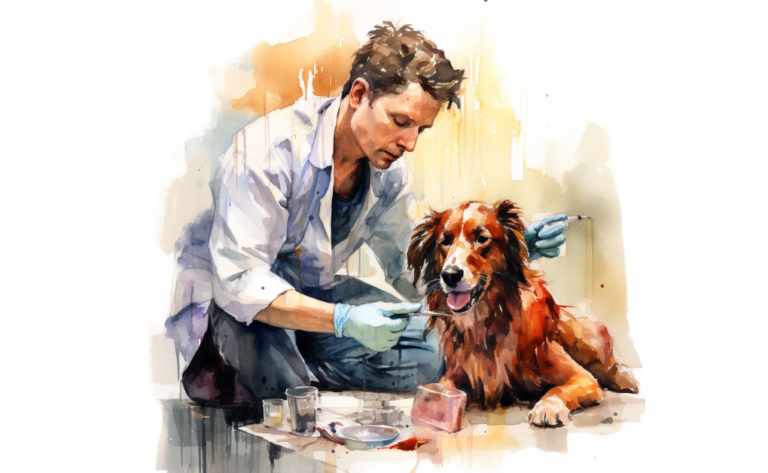What is Diabetes Mellitus in Dogs?
What is it?
How is it Treated?
Breed Predispositions
Poodle Beagle Miniature Schnauzer Dachshund Samoyed Australian Terrier Bichon Frise Keeshond Cairn Terrier Golden Retriever
Introduction
Over the past few weeks, Susan had noticed some concerning changes in her beloved Schnauzer, Toby. He was constantly thirsty, urinating more frequently, and losing weight despite having a healthy appetite. Unsure of what could be causing these symptoms, Susan scheduled an appointment with her trusted veterinarian. After conducting blood tests and a thorough examination, the vet revealed that Toby had diabetes mellitus, a diagnosis that Susan hadn’t anticipated. In this blog post, we’ll explore diabetes mellitus in dogs.
Diabetes mellitus, often just termed diabetes, represents a persistent endocrine disease in dogs that interferes with regulating blood sugar levels. The condition in dogs is predominantly analogous to Type 1 diabetes, as seen in humans.
This ailment stems from the dog’s body’s failure to manufacture or effectively employ insulin, a hormone synthesized by the pancreas. Insulin performs a critical function in aiding the absorption of glucose (a type of sugar) from the bloodstream into cells, serving as an energy source.
When a dog is grappling with the development of diabetes mellitus, its body either fails to generate adequate insulin or the cells exhibit an inappropriate response to the insulin produced. This malfunction subsequently leads to elevated glucose levels circulating in the bloodstream, a factor that paves the way for various complications associated with diabetes mellitus.
Types of Diabetes Mellitus in Dogs
Diabetes mellitus, a condition impairing the body’s ability to process sugar, presents in dogs primarily as Insulin-Deficiency Diabetes (IDD) and Insulin-Resistance Diabetes (IRD). These conditions impact blood sugar regulation differently due to distinct causes and typical patient profiles.
Insulin-Deficiency Diabetes (IDD)
Diabetes mellitus in dogs, like humans, can stem from various causes. These can be associated with two types of diabetes: Insulin-Dependent Diabetes Mellitus (also known as type I or insulin-deficiency diabetes – IDD) and Uncomplicated Diabetes Mellitus (also known as type II or insulin-resistance diabetes – IRD). Here are the different causes:
1. Insulin-Dependent Diabetes Mellitus (IDD)
IDD occurs when the beta cells in the pancreas, responsible for producing and releasing insulin, are destroyed.
Several factors can contribute to this destruction:
- Immune-mediated disease: This condition involves the immune system mistakenly attacking and destroying the beta cells, rendering them incapable of producing insulin. This immune reaction is believed to be influenced by genetic factors, with certain breeds like Samoyeds and Australian Terriers showing predisposition.
- Pancreatitis: Chronic pancreas inflammation can damage this organ, potentially affecting the beta cells and their insulin production capabilities.
- Idiopathic cause: In some instances, the cause of the beta cell destruction remains unknown.
2. Uncomplicated Diabetes Mellitus (IRD)
In cases of IRD, the body produces insulin, but the body cells resist its effects. The following factors can contribute to this insulin resistance:
- Obesity: Overweight dogs are more prone to insulin resistance. Excessive body weight is a well-documented risk factor for this type of diabetes.
- Hormonal Disorders: Certain hormonal diseases, such as Cushing’s disease, can interfere with the efficacy of insulin, leading to insulin resistance. These diseases result in a persistent state of elevated cortisol levels, a hormone that antagonizes insulin’s action.
- Medication: Some medications, like glucocorticoids and progestins, can induce insulin resistance long-term or at high doses.
- Age and Breed: Older dogs and certain breeds like Poodles, Dachshunds, and Beagles are more prone to IRD.
Recognizing the causes of each type of diabetes can inform prevention strategies and guide appropriate management, contributing to a better prognosis for dogs with diabetes.

Causes of Diabetes Mellitus in Dogs
Diabetes mellitus in dogs, like humans, can stem from various causes. These can be associated with two types of diabetes: Insulin-Dependent Diabetes Mellitus (also known as type I or insulin-deficiency diabetes – IDD) and Uncomplicated Diabetes Mellitus (also known as type II or insulin-resistance diabetes – IRD). Here are the different causes:
1. Insulin-Dependent Diabetes Mellitus (IDD)
IDD occurs when the beta cells in the pancreas, responsible for producing and releasing insulin, are destroyed.
Several factors can contribute to this destruction:
- Immune-mediated disease: This condition involves the immune system mistakenly attacking and destroying the beta cells, rendering them incapable of producing insulin. This immune reaction is believed to be influenced by genetic factors, with certain breeds like Samoyeds and Australian Terriers showing predisposition.
- Pancreatitis: Chronic pancreas inflammation can damage this organ, potentially affecting the beta cells and their insulin production capabilities.
- Idiopathic cause: In some instances, the cause of the beta cell destruction remains unknown.
2. Insulin-Resistance Diabetes (IRD)
In cases of IRD, the body produces insulin, but the body cells resist its effects. The following factors can contribute to this insulin resistance:
- Obesity: Overweight dogs are more prone to insulin resistance. Excessive body weight is a well-documented risk factor for this type of diabetes.
- Hormonal Disorders: Certain hormonal diseases, such as Cushing’s disease, can interfere with the efficacy of insulin, leading to insulin resistance. These diseases result in a persistent state of elevated cortisol levels, a hormone that antagonizes insulin’s action.
- Medication: Some medications, like glucocorticoids and progestins, can induce insulin resistance long-term or at high doses.
- Age and Breed: Older dogs and certain breeds like Poodles, Dachshunds, and Beagles are more prone to IRD.
Recognizing the causes of each type of diabetes can inform prevention strategies and guide appropriate management, contributing to a better prognosis for dogs with diabetes.
Symptoms of Diabetes Mellitus in Dogs
Dogs with diabetes mellitus often exhibit the following symptoms:
- Increased thirst
- Frequent urination
- Weight loss despite normal or increased appetite
- Excessive hunger
- High blood sugar levels
- Presence of sugar in the urine
- Tiredness or lethargy
- Urinary tract infections
- Cataracts (leading to blindness in dogs)
- Chronic skin infections
- Poor coat condition
Diagnosing Diabetes Mellitus in Dogs
Blood Tests
Crucial to diagnosing diabetes mellitus in dogs are blood tests, with heightened blood glucose levels, known as hyperglycemia, often hinting at diabetes. However, due to the possibility of stress also elevating glucose levels, veterinarians may consider fructosamine levels an indicator of prolonged hyperglycemia.
Urine Tests
To confirm a diagnosis of diabetes, urine tests typically accompany blood analyses. The presence of glucose and potentially ketones in the urine, known as glycosuria and ketonuria, respectively, are recognized as signs of diabetes.
Physical Examination and Clinical Signs
Veterinarians consider the dog’s overall physical health and the descriptions of the dog’s symptoms provided by the owner. This includes paying close attention to clinical signs like increased thirst and urination, alterations in appetite, weight loss, and possibly other symptoms tied to complications from diabetes, such as cataracts or recurrent infections.
Further Diagnostic Tests
If diabetes mellitus is confirmed, further tests may be initiated to gauge the dog’s overall health and screen for complications related to diabetes. These might encompass liver and kidney function tests, pancreatic functionality and insulin secretion evaluations, and checks for secondary infections.
Conducting these comprehensive assessments aid veterinarians in designing the most effective treatment plan suitable for each dog’s body condition, especially those diagnosed with diabetes or other chronic conditions.
Treatment of Diabetes Mellitus in Dogs

The selection of treatment strategies for diabetes depends significantly on the severity of the condition and the specific needs of each canine patient. The options encompass dietary adjustments, medications, and insulin administration.
Insulin-Based Therapy
Nearly all dogs diagnosed with diabetes will require exogenous insulin injections, typically given twice daily via a syringe—the precise dosage and kind of insulin hinge upon each dog’s needs and reaction to treatment. Pet owners are commonly taught how to administer these insulin injections at home.
Nutritional Management
A fundamental element in handling diabetes is maintaining a consistent, balanced diet. The optimal diet for a diabetic dog usually includes high fiber and complex carbohydrates that encourage slow and steady glucose absorption. Regular feeding schedules hold equal importance, with meals ideally aligning with peak insulin levels.
Consistent Exercise
Regular, moderate physical activity can assist in controlling blood sugar levels and maintaining a healthy weight, which enhances insulin sensitivity. However, the exercise schedule should be consistent, as abrupt increases in physical activity can trigger hypoglycemia or low blood sugar.
Routine Health Surveillance
Frequent veterinary visits are vital for monitoring the dog’s response to treatment and adjusting the insulin dose as necessary. In addition, veterinary internal medicine professionals usually use blood glucose curves to measure blood sugar levels over several hours on specific days.
Addressing Secondary Symptoms or Complications
The development of diabetes can instigate several complications, such as urinary tract infections, kidney disease, or diabetic neuropathy stemming from insulin deficiency. These must be rapidly identified and treated to safeguard the dog’s health.
It’s crucial to remember that although diabetes is a lifelong condition, with appropriate treatment and management, including regular insulin therapy, dogs with diabetes can lead a normal, healthy life.
Prevention of Diabetes in Dogs
Certain strategies exist for pet owners to potentially ward off the onset of diabetes mellitus in their pets:
- Uphold a Nutritious Diet – Providing your pet with a balanced diet, rich in fiber and low in fat, can be instrumental in preventing diabetes. In addition, avoid food items with high sugar content and maintain regular feeding schedules to stabilize blood sugar levels, ensuring an appropriate amount of insulin in the body.
- Consistent Exercise – Regular physical activity is critical in maintaining a healthy weight for your pet, which, in turn, can lower the risk of diabetes. Regular walks, interactive play sessions, and other physical activities can keep your pet healthy and fit.
- Weight Regulation – Pets carrying excess weight are more likely to develop diabetes, hence the importance of maintaining an optimal body weight for your pet. This may involve controlling portion sizes, curbing excessive treats, and ensuring regular exercise.
- Routine Veterinary Visits – Regular vet check-ups can help detect early signs of diabetes and other health conditions that may increase the risk of diabetes. Your vet can provide tailored advice based on your pet’s breed, age, and overall health condition.
- Circumspect Medication Use – Some medicines, such as steroids, can increase the risk of diabetes in pets. These medications should only be administered as directed by your vet, and any concerns should be discussed with them.
Remember, while these steps can help reduce the risk of diabetes, they do not guarantee that your pet will not develop the disease. Age, breed, and genetics can also contribute to a pet’s risk. Therefore, as a conscientious pet owner, it’s crucial to regularly monitor your pet’s health and consult your vet if you notice any changes to keep them healthy.
Frequently Asked Questions
Disclaimer: The information provided on this veterinary website is intended for general educational purposes only and should not be considered as a substitute for professional veterinary advice, diagnosis, or treatment. Always consult a licensed veterinarian for any concerns or questions regarding the health and well-being of your pet. This website does not claim to cover every possible situation or provide exhaustive knowledge on the subjects presented. The owners and contributors of this website are not responsible for any harm or loss that may result from the use or misuse of the information provided herein.







